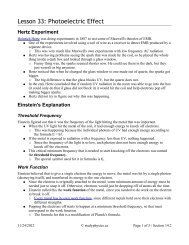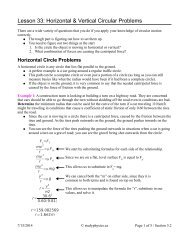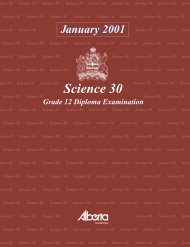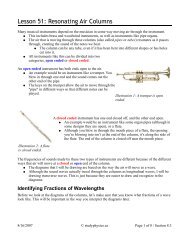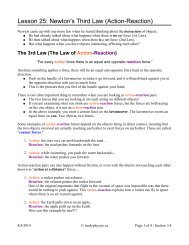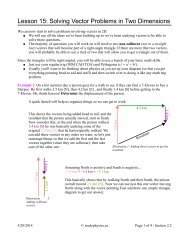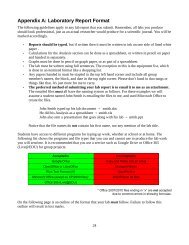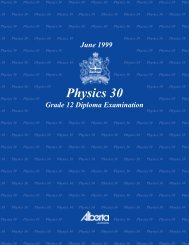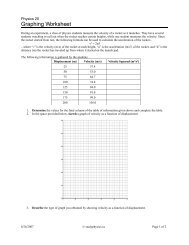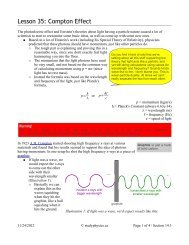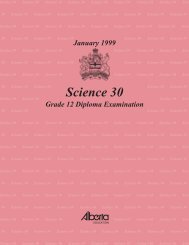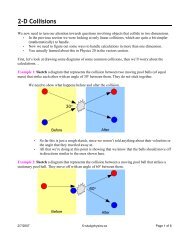Science 30
Science 30
Science 30
You also want an ePaper? Increase the reach of your titles
YUMPU automatically turns print PDFs into web optimized ePapers that Google loves.
cience <strong>30</strong> <strong>Science</strong> <strong>30</strong> <strong>Science</strong> <strong>30</strong> <strong>Science</strong> <strong>30</strong> <strong>Science</strong> <strong>30</strong> <strong>Science</strong> <strong>30</strong> <strong>Science</strong> <strong>30</strong> <strong>Science</strong> <strong>30</strong> Scien<br />
<strong>Science</strong> <strong>30</strong> <strong>Science</strong> <strong>30</strong> <strong>Science</strong> <strong>30</strong> <strong>Science</strong> <strong>30</strong> <strong>Science</strong> <strong>30</strong> <strong>Science</strong> <strong>30</strong> <strong>Science</strong> <strong>30</strong> <strong>Science</strong> <strong>30</strong><br />
January 2002<br />
cience <strong>30</strong> <strong>Science</strong> <strong>30</strong> <strong>Science</strong> <strong>30</strong> <strong>Science</strong> <strong>30</strong> <strong>Science</strong> <strong>30</strong> <strong>Science</strong> <strong>30</strong> <strong>Science</strong> <strong>30</strong> <strong>Science</strong> <strong>30</strong> Scien<br />
<strong>Science</strong> <strong>30</strong> <strong>Science</strong> <strong>30</strong> <strong>Science</strong> <strong>30</strong> <strong>Science</strong> <strong>30</strong> <strong>Science</strong> <strong>30</strong> <strong>Science</strong> <strong>30</strong> <strong>Science</strong> <strong>30</strong> <strong>Science</strong> <strong>30</strong><br />
cience <strong>30</strong> <strong>Science</strong> <strong>30</strong> <strong>Science</strong> <strong>30</strong> <strong>Science</strong> <strong>30</strong> <strong>Science</strong> <strong>30</strong> <strong>Science</strong> <strong>30</strong> <strong>Science</strong> <strong>30</strong> <strong>Science</strong> <strong>30</strong> Scien<br />
<strong>Science</strong> <strong>30</strong> <strong>Science</strong> <strong>30</strong> <strong>Science</strong> <strong>30</strong> <strong>Science</strong> <strong>30</strong> <strong>Science</strong> <strong>30</strong> <strong>Science</strong> <strong>30</strong> <strong>Science</strong> <strong>30</strong> <strong>Science</strong> <strong>30</strong><br />
ience <strong>30</strong> <strong>Science</strong> <strong>30</strong> <strong>Science</strong> <strong>30</strong> <strong>Science</strong> <strong>30</strong> <strong>Science</strong> <strong>30</strong> <strong>Science</strong> <strong>30</strong> <strong>Science</strong> <strong>30</strong> <strong>Science</strong> <strong>30</strong> Scienc<br />
<strong>Science</strong> <strong>30</strong><br />
<strong>Science</strong> <strong>30</strong> <strong>Science</strong> <strong>30</strong> <strong>Science</strong> <strong>30</strong> <strong>Science</strong> <strong>30</strong> <strong>Science</strong> <strong>30</strong> <strong>Science</strong> <strong>30</strong> <strong>Science</strong> <strong>30</strong> <strong>Science</strong> <strong>30</strong><br />
Grade 12 Diploma Examination<br />
cience <strong>30</strong> <strong>Science</strong> <strong>30</strong> <strong>Science</strong> <strong>30</strong> <strong>Science</strong> <strong>30</strong> <strong>Science</strong> <strong>30</strong> <strong>Science</strong> <strong>30</strong> <strong>Science</strong> <strong>30</strong> <strong>Science</strong> <strong>30</strong> Scien<br />
<strong>Science</strong> <strong>30</strong> <strong>Science</strong> <strong>30</strong> <strong>Science</strong> <strong>30</strong> <strong>Science</strong> <strong>30</strong> <strong>Science</strong> <strong>30</strong> <strong>Science</strong> <strong>30</strong> <strong>Science</strong> <strong>30</strong> <strong>Science</strong> <strong>30</strong><br />
cience <strong>30</strong> <strong>Science</strong> <strong>30</strong> <strong>Science</strong> <strong>30</strong> <strong>Science</strong> <strong>30</strong> <strong>Science</strong> <strong>30</strong> <strong>Science</strong> <strong>30</strong> <strong>Science</strong> <strong>30</strong> <strong>Science</strong> <strong>30</strong> Scien<br />
<strong>Science</strong> <strong>30</strong> <strong>Science</strong> <strong>30</strong> <strong>Science</strong> <strong>30</strong> <strong>Science</strong> <strong>30</strong> <strong>Science</strong> <strong>30</strong> <strong>Science</strong> <strong>30</strong> <strong>Science</strong> <strong>30</strong> <strong>Science</strong> <strong>30</strong><br />
cience <strong>30</strong> <strong>Science</strong> <strong>30</strong> <strong>Science</strong> <strong>30</strong> <strong>Science</strong> <strong>30</strong> <strong>Science</strong> <strong>30</strong> <strong>Science</strong> <strong>30</strong> <strong>Science</strong> <strong>30</strong> <strong>Science</strong> <strong>30</strong> Scien<br />
<strong>Science</strong> <strong>30</strong> <strong>Science</strong> <strong>30</strong> <strong>Science</strong> <strong>30</strong> <strong>Science</strong> <strong>30</strong> <strong>Science</strong> <strong>30</strong> <strong>Science</strong> <strong>30</strong> <strong>Science</strong> <strong>30</strong> <strong>Science</strong> <strong>30</strong><br />
cience <strong>30</strong> <strong>Science</strong> <strong>30</strong> <strong>Science</strong> <strong>30</strong> <strong>Science</strong> <strong>30</strong> <strong>Science</strong> <strong>30</strong> <strong>Science</strong> <strong>30</strong> <strong>Science</strong> <strong>30</strong> <strong>Science</strong> <strong>30</strong> Scien<br />
<strong>Science</strong> <strong>30</strong> <strong>Science</strong> <strong>30</strong> <strong>Science</strong> <strong>30</strong> <strong>Science</strong> <strong>30</strong> <strong>Science</strong> <strong>30</strong> <strong>Science</strong> <strong>30</strong> <strong>Science</strong> <strong>30</strong> <strong>Science</strong> <strong>30</strong><br />
cience <strong>30</strong> <strong>Science</strong> <strong>30</strong> <strong>Science</strong> <strong>30</strong> <strong>Science</strong> <strong>30</strong> <strong>Science</strong> <strong>30</strong> <strong>Science</strong> <strong>30</strong> <strong>Science</strong> <strong>30</strong> <strong>Science</strong> <strong>30</strong> Scien<br />
<strong>Science</strong> <strong>30</strong> <strong>Science</strong> <strong>30</strong> <strong>Science</strong> <strong>30</strong> <strong>Science</strong> <strong>30</strong> <strong>Science</strong> <strong>30</strong> <strong>Science</strong> <strong>30</strong> <strong>Science</strong> <strong>30</strong> <strong>Science</strong> <strong>30</strong><br />
cience <strong>30</strong> <strong>Science</strong> <strong>30</strong> <strong>Science</strong> <strong>30</strong> <strong>Science</strong> <strong>30</strong> <strong>Science</strong> <strong>30</strong> <strong>Science</strong> <strong>30</strong> <strong>Science</strong> <strong>30</strong> <strong>Science</strong> <strong>30</strong> Scien
Copyright 2002, the Crown in Right of Alberta, as represented by the Minister of Learning, Alberta<br />
Learning, Learner Assessment Branch, 11160 Jasper Avenue, Edmonton, Alberta T5K 0L2. All rights<br />
reserved. Additional copies may be purchased from the Learning Resource Centre.<br />
Special permission is granted to Alberta educators only to reproduce, for educational purposes and on a<br />
non-profit basis, parts of this examination that do not contain excerpted material only after the<br />
administration of this examination.<br />
Excerpted material in this examination shall not be reproduced without the written permission of the<br />
original publisher (see credits page, where applicable).
January 2002<br />
<strong>Science</strong> <strong>30</strong><br />
Grade 12 Diploma Examination<br />
Description<br />
Time: This examination was developed<br />
to be completed in 2.5 h; however, you<br />
may take an additional 0.5 h to complete<br />
the examination.<br />
This is a closed-book examination<br />
consisting of<br />
• 40 multiple-choice and 12 numericalresponse<br />
questions of equal value,<br />
worth 65% of the examination<br />
• 1 short-answer question and 2 longanswer<br />
questions, worth 35% of the<br />
examination<br />
This examination contains sets<br />
of related questions.<br />
A set of questions may contain<br />
multiple-choice and/or numericalresponse<br />
and/or written-response<br />
questions.<br />
A science data booklet is provided for<br />
your reference.<br />
Note: The perforated pages at the back of<br />
this booklet may be torn out and used for<br />
your rough work. No marks will be given<br />
for work done on the tear-out pages.<br />
Instructions<br />
• You are expected to provide your own<br />
calculator. You may use any scientific<br />
calculator or a graphing calculator<br />
approved by Alberta Learning.<br />
• You are expected to have cleared your<br />
calculator of all information that is<br />
stored in the programmable or<br />
parametric memory.<br />
• Use only an HB pencil for the machinescored<br />
answer sheet.<br />
• Fill in the information required on the<br />
answer sheet and the examination<br />
booklet as directed by the presiding<br />
examiner.<br />
• Read each question carefully.<br />
• Consider all numbers used in the<br />
examination to be the result of a<br />
measurement or observation.<br />
• When performing calculations, use the<br />
values of the constants provided in the<br />
data booklet. Do not use the values<br />
programmed in your calculator.<br />
• If you wish to change an answer, erase<br />
all traces of your first answer.<br />
• Do not fold the answer sheet.<br />
• The presiding examiner will collect your<br />
answer sheet and examination booklet<br />
and send them to Alberta Learning.<br />
• Now turn this page and read the detailed<br />
instructions for answering machinescored<br />
and written-response questions.
Multiple Choice<br />
• Decide which of the choices best<br />
completes the statement or answers<br />
the question.<br />
• Locate that question number on the<br />
separate answer sheet provided and<br />
fill in the circle that corresponds to<br />
your choice.<br />
Example<br />
This examination is for the subject of<br />
A. science<br />
B. biology<br />
C. physics<br />
D. chemistry<br />
Answer Sheet<br />
A B C D<br />
Numerical Response<br />
• Record your answer on the answer<br />
sheet provided by writing it in the<br />
boxes and then filling in the<br />
corresponding circles.<br />
• If an answer is a value between 0 and 1<br />
(e.g., 0.25), then be sure to record the 0<br />
before the decimal place.<br />
• Enter the first digit of your answer<br />
in the left-hand box and leave any<br />
unused boxes blank.<br />
Examples<br />
Calculation Question and Solution<br />
The average of the values 21.0, 25.5, and<br />
24.5 is _________.<br />
(Record your three-digit answer in the<br />
numerical-response section on the answer<br />
sheet.)<br />
Average = (21.0 + 25.5 + 24.5)/3<br />
= 23.666<br />
= 23.7 (rounded to three digits)<br />
Record 23.7 on the<br />
answer sheet 2 3 . 7<br />
. .<br />
0 0 0 0<br />
1 1 1 1<br />
2 2 2 2<br />
3 3 3 3<br />
4 4 4 4<br />
5 5 5 5<br />
6 6 6 6<br />
7 7 7 7<br />
8 8 8 8<br />
9 9 9 9<br />
ii
Written Response<br />
Correct-Order Question and Solution<br />
When the following subjects are arranged in<br />
alphabetical order, the order is ____, ____,<br />
____, and ____ .<br />
1 physics<br />
2 biology<br />
3 science<br />
4 chemistry<br />
(Record all four digits of your answer in the<br />
numerical-response section on the answer<br />
sheet.)<br />
Answer: 2413<br />
Record 2413 on the<br />
answer sheet<br />
2 4 1 3<br />
. .<br />
0 0 0 0<br />
1 1 1 1<br />
2 2 2 2<br />
3 3 3 3<br />
4 4 4 4<br />
5 5 5 5<br />
6 6 6 6<br />
7 7 7 7<br />
8 8 8 8<br />
9 9 9 9<br />
• Write your responses in the examination<br />
booklet as neatly as possible.<br />
• For full marks, your responses must<br />
address all aspects of the question.<br />
• Descriptions and/or explanations of<br />
concepts must be correct and include<br />
pertinent ideas, diagrams, calculations,<br />
and formulas.<br />
• Your responses must be presented in a<br />
well-organized manner using complete<br />
sentences, correct units and correct<br />
significant digits, where appropriate.<br />
• Relevant scientific, technological, and/or<br />
societal concepts and examples must be<br />
identified and made explicit.<br />
iii
Staff at a medical clinic are familiar with body systems and the technologies used<br />
to treat problems associated with them.<br />
Biconcave<br />
Use the following diagrams to answer the first question.<br />
Cell type M<br />
Stained Blood Components<br />
Cell type N<br />
2 µm<br />
Irregularshaped<br />
8.5 µm nucleus<br />
Non-stained<br />
granules<br />
10–15 µm<br />
Cell type P<br />
Clear outer zone<br />
2–4 µm<br />
Blue-stained inner zone<br />
1. Cell types M, N, and P shown above represent, respectively,<br />
A. a red blood cell, a white blood cell, and platelets<br />
B. a red blood cell, a platelet, and white blood cells<br />
C. a platelet, a red blood cell, and white blood cells<br />
D. a platelet, a white blood cell, and red blood cells<br />
2. Which of the following defence system components is not considered part of the<br />
body’s first defence against infection<br />
A. Tears<br />
B. Skin cells<br />
C. Stomach acid<br />
D. Helper T cells<br />
1
Use the following information to answer the next question.<br />
A faulty heart valve allows blood to flow back into a previous chamber. This<br />
condition may be treated by replacing the faulty valve with a mechanical one.<br />
To open<br />
To close<br />
3. In some patients, blood flows back through a defective valve into the right atrium.<br />
In which of the diagrams below is the mechanical valve placed so that it would<br />
correct this problem<br />
A. B.<br />
C. D.<br />
2
4. The mechanisms that control blood flow in arteries are different than the<br />
mechanisms that control blood flow in veins. In arteries,<br />
A. there are no valves<br />
B. the valves are attached to muscles<br />
C. valves only exist in secondary vessels<br />
D. the valves are positioned in the opposite direction of the blood flow in veins<br />
5. The type of blood vessel that releases nutrients and oxygen to the tissues is called<br />
A. a vein<br />
B. a venule<br />
C. an artery<br />
D. a capillary<br />
6. If a patient’s resting blood pressure was 160/100, then the patient would have<br />
A. lower-than-average systolic and diastolic pressure<br />
B. higher-than-average systolic and diastolic pressure<br />
C. higher-than-average systolic pressure and lower-than-average diastolic<br />
pressure<br />
D. lower-than-average systolic pressure and higher-than-average diastolic<br />
pressure<br />
3
Use the following information to answer the next question.<br />
Disease-Fighting Mechanisms<br />
1 Vaccines<br />
2 Antibiotics<br />
3 Antibodies<br />
4 Gene therapy<br />
Numerical Response<br />
1. Match each of the mechanisms listed above with its description given below. Use<br />
each number only once.<br />
Proteins that combine with specific antigens _____ (Record in the first column)<br />
The replacement of defective alleles with<br />
normal alleles _____ (Record in the second column)<br />
Weakened viruses that produce immunity _____ (Record in the third column)<br />
Compounds developed to kill bacteria _____ (Record in the fourth column)<br />
(Record all four digits of your answer in the numerical-response section on the answer sheet.)<br />
7. Foreign proteins in the blood stimulate an immune response. In which of the<br />
following rows is a type of white blood cell paired with its function<br />
Row White Blood Cell Function<br />
A. Macrophages Ingest antigens<br />
B. B cells Start immune response<br />
C. Helper T cells Stop immune response<br />
D. Killer (cytotoxic) T cells Produce antibodies<br />
4
Use the following information to answer the next question.<br />
Some Steps Involved in the Development of Immunity<br />
1 Helper T cells stimulate B cells to produce antibodies.<br />
2 Macrophages present antigens to T cells.<br />
3 Memory T cells remain in the body, ready in case a familiar antigen<br />
enters the body at a later time.<br />
4 Suppressor T cells turn off the immune response.<br />
Numerical Response<br />
2. The steps above, arranged in the order in which they occur, are<br />
_____ , _____ , _____ , and _____ .<br />
first<br />
last<br />
(Record all four digits of your answer in the numerical-response section on the answer sheet.)<br />
5
Use the following information to answer the next question.<br />
Neurons<br />
Interneuron<br />
(Association neuron)<br />
Motor neuron<br />
Nerve networks perform an important communication function in the body.<br />
Some events that occur in the transfer of a nerve impulse from an interneuron<br />
to a motor neuron are listed below.<br />
1 An impulse moves along the motor neuron dendrite.<br />
2 Cholinesterase breaks apart acetylcholine molecules.<br />
3 An impulse moves along the interneuron axon.<br />
4 An interneuron axon releases acetylcholine molecules into synapse;<br />
acetylcholine attaches to the membrane of the motor neuron dendrite.<br />
Numerical Response<br />
3. The events above, listed in the order in which they occur, are _____, _____,<br />
_____, and _____.<br />
(Record all four digits of your answer in the numerical-response section on the answer sheet.)<br />
8. A motor neuron conducts impulses from<br />
A. muscles to glands<br />
B. glands to muscles<br />
C. the central nervous system to muscles and glands<br />
D. muscles and glands to the central nervous system<br />
6
9. Light rays pass through the structures of the eye in the sequence<br />
A. lens → cornea → pupil → retina<br />
B. pupil → cornea → retina → lens<br />
C. cornea → lens → pupil → retina<br />
D. cornea → pupil → lens → retina<br />
10. The human eye generates nerve impulses in response to wavelengths that range from<br />
A. 10 to 50 nm<br />
B. 400 to 700 nm<br />
C. 2 000 to 4 000 nm<br />
D. 20 000 to 50 000 nm<br />
7
Use the following information to answer the next three questions.<br />
Cell Division<br />
ACAC<br />
ACAC<br />
ACTC<br />
ACTC<br />
Process 1<br />
Cell 3<br />
Cell A<br />
Cell C<br />
ACAC<br />
ACAC<br />
Cell 4<br />
ACTC<br />
ACTC<br />
Process 2<br />
Cell B<br />
Cell D<br />
11. The cells above that would contain both sets of genetic information (ACAC and<br />
ACTC) are<br />
A. cell 3 and cell 4<br />
B. cell 3 and cell C<br />
C. cell 4 and cell D<br />
D. cell C and cell D<br />
8
12. In the cell division diagram, the type of cell represented by cell 3 is<br />
A. a zygote<br />
B. an egg cell<br />
C. a body cell<br />
D. a sperm cell<br />
Numerical Response<br />
4. Match each of the numbered processes and cells in the cell division diagram with<br />
the term below that describes it. Use each number only once.<br />
Mitosis _____ (Record in the first column)<br />
Meiosis _____ (Record in the second column)<br />
Haploid _____ (Record in the third column)<br />
Diploid _____ (Record in the fourth column)<br />
(Record all four digits of your answer in the numerical-response section on the answer sheet.)<br />
9
13. DNA can be described as<br />
A. an expression of a trait<br />
B. a strand of protein that attacks foreign antigens<br />
C. a sequence of bases on a sugar-phosphate backbone<br />
D. a single stranded unit composed of sugar, phosphate, and a base<br />
Use the following information to answer the next two questions.<br />
The radiation that is sometimes used to treat cancer may be provided by<br />
radium-226 undergoing alpha-decay according to the equation<br />
226 Ra 4 222<br />
88<br />
→<br />
2<br />
He +<br />
86 Rn +<br />
gamma radiation<br />
Numerical Response<br />
5. What is the amount of energy released when one mole of radium-226 decays to<br />
form radon-222<br />
Answer: __________ × 10 11 J/mol<br />
(Record your three-digit answer in the numerical-response section on the answer sheet.)<br />
14. A fusion reaction differs from a fission reaction in that a fusion reaction involves<br />
A. large atomic nuclei splitting to form smaller atomic nuclei<br />
B. smaller atomic nuclei combining to form larger atomic nuclei<br />
C. the release of energy, whereas fission involves the absorption of energy<br />
D. the absorption of energy, whereas fission involves the release of energy<br />
10
Use the following information to answer the next question.<br />
Electromagnetic radiation has many applications inside and outside of the<br />
medical field.<br />
Electromagnetic Waves<br />
1 Infrared<br />
2 Radio<br />
3 Gamma<br />
4 Visible light<br />
Numerical Response<br />
6. Match each of the electromagnetic waves numbered above with its most common<br />
use, as given below. Use each number only once.<br />
Cancer treatment _____ (Record in the first column)<br />
Communication _____ (Record in the second column)<br />
To see objects _____ (Record in the third column)<br />
To warm food _____ (Record in the fourth column)<br />
(Record all four digits of your answer in the numerical-response section on the answer sheet.)<br />
11
Environmental technicians collect and analyze air, water, and soil samples.<br />
Use the following information to answer the next two questions.<br />
Water Sampling Sites<br />
Site 3<br />
Prevailing wind<br />
River<br />
Coal<br />
strip mine<br />
Townsite<br />
Lake<br />
Site 2<br />
Site 4<br />
Coal-burning<br />
generating<br />
station<br />
Lake<br />
Site 1<br />
Water samples were collected and analyzed from the four sites marked on the<br />
map above. The following data were obtained.<br />
Temperature<br />
[H 3 O + (aq)]<br />
Organic matter (ppm)<br />
Dissolved O 2 (ppm)<br />
Site 1 Site 2 Site 3 Site 4<br />
9°C<br />
6°C<br />
4°C<br />
5°C<br />
1.6 × 10 –6 mol/L 6.3 × 10 –5 mol/L 1.0 × 10 –6 mol/L 1.3 × 10 –5 mol/L<br />
4.7<br />
15. Fish that require a high level of dissolved oxygen would likely thrive at<br />
A. site 1<br />
B. site 2<br />
C. site 3<br />
D. site 4<br />
__________________________<br />
16. If a substance has a basic pH, then the pH for that substance is<br />
A. less than 7 and will turn red litmus blue<br />
B. less than 7 and will turn blue litmus red<br />
C. greater than 7 and will turn red litmus blue<br />
D. greater than 7 and will turn blue litmus red<br />
17. Fish-eating birds in a test area were found to have a higher concentration of<br />
dioxins than the fish they eat. This is a result of<br />
A. biodiversity<br />
B. biofeedback<br />
C. bioselectivity<br />
D. biomagnification<br />
18. Farmers in an area want to try a new pesticide that contains a chemical called<br />
ivermectin. This compound is similar to DDT in that it is a very stable compound<br />
and does not dissolve easily in water. Those who oppose the use of ivermectin are<br />
concerned that ivermectin will<br />
A. be target specific<br />
B. be excreted by target organisms<br />
C. biodegrade too quickly to be effective<br />
D. accumulate in increasing concentrations in the food chain<br />
13
Use the following information to answer the next question.<br />
A technician tests the environment for different organic compounds.<br />
Structural Formulas of Four Organic Compounds<br />
I<br />
H<br />
H<br />
H<br />
II<br />
H<br />
O<br />
H<br />
–<br />
–<br />
–<br />
H – C – C – C – OH<br />
–<br />
=<br />
–<br />
H – C – C – C – H<br />
H<br />
H<br />
H<br />
–<br />
–<br />
–<br />
–<br />
H<br />
–<br />
H<br />
III<br />
H H O<br />
–<br />
–<br />
=<br />
H – C – C – C – OH<br />
H<br />
H<br />
–<br />
–<br />
IV<br />
H<br />
–<br />
H – C – C<br />
–<br />
H<br />
H<br />
–<br />
–<br />
H<br />
=O<br />
– C–<br />
H<br />
19. Which of the structural formulas above represents an alcohol<br />
A. Compound I<br />
B. Compound II<br />
C. Compound III<br />
D. Compound IV<br />
14
Use the following information to answer the next question.<br />
Genetic Engineering Used to Control Weeds<br />
Weeds may dramatically reduce food crop yields. One solution is to plant<br />
seeds that have been genetically engineered to have resistance to herbicides.<br />
After the crop is planted, herbicides can be applied to wipe out the weeds in<br />
the crop.<br />
Short Answer––5%<br />
Outline the risks and benefits that may be associated with using this method of weed<br />
control. You may use paragraph format, point-form notes, and/or tables in your answer.<br />
...............................................................................................................................................<br />
...............................................................................................................................................<br />
...............................................................................................................................................<br />
...............................................................................................................................................<br />
...............................................................................................................................................<br />
...............................................................................................................................................<br />
...............................................................................................................................................<br />
...............................................................................................................................................<br />
...............................................................................................................................................<br />
...............................................................................................................................................<br />
...............................................................................................................................................<br />
...............................................................................................................................................<br />
...............................................................................................................................................<br />
...............................................................................................................................................<br />
...............................................................................................................................................<br />
...............................................................................................................................................<br />
...............................................................................................................................................<br />
...............................................................................................................................................<br />
...............................................................................................................................................<br />
15
–<br />
–<br />
–<br />
–<br />
–<br />
–<br />
20. Bromomethane, used in some pesticides, is being phased out over time. It is<br />
capable of breaking down large amounts of ozone in the upper atmosphere. The<br />
structural formula for bromomethane is<br />
A.<br />
H<br />
B.<br />
H<br />
O<br />
–<br />
H – C – H<br />
–<br />
=<br />
H – C – C – Br<br />
Br<br />
H<br />
H<br />
C.<br />
H<br />
D.<br />
H<br />
H<br />
–<br />
H – C – Cl<br />
–<br />
–<br />
Cl – C – C – Br<br />
Br<br />
H<br />
H<br />
21. The type of radiation that is absorbed by ozone in the upper atmosphere is<br />
A. X-ray radiation<br />
B. infrared radiation<br />
C. ultraviolet radiation<br />
D. gamma ray radiation<br />
22. Depletion of the ozone layer can lead to an increase in the occurrence of cataracts.<br />
Cataracts cause vision problems by blocking some of the light that passes through<br />
the eye. Cataracts are located in the<br />
A. lens<br />
B. rods<br />
C. cones<br />
D. retina<br />
16
Use the following information to answer the next two questions.<br />
In the analysis of water from a lake, a technician detected the following four<br />
acids in the concentrations given.<br />
1 HNO 2(aq) 4.00 × 10 –3 mol/L<br />
2 HNO 3(aq) 2.50 × 10 –5 mol/L<br />
3 H 2 SO 3(aq) 3.50 × 10 –4 mol/L<br />
4 H 2 SO 4(aq) 4.50 × 10 –5 mol/L<br />
23. The weakest acid that the technician detected was<br />
A. HNO 2(aq)<br />
B. HNO 3(aq)<br />
C. H 2 SO 3(aq)<br />
D. H 2 SO 4(aq)<br />
Numerical Response<br />
8. The four acids above, listed in order from most concentrated to least concentrated,<br />
are _____ , _____ , _____ , and _____ .<br />
most<br />
least<br />
concentrated<br />
concentrated<br />
(Record all four digits of your answer in the numerical-response section on the answer sheet.)<br />
17
Use the following information to answer the next question.<br />
Test Results of Four Soil Samples Analyzed by an<br />
Environmental Testing Laboratory<br />
Sample<br />
Pesticides<br />
mg/kg<br />
Lead<br />
mg/kg<br />
PCBs<br />
mg/kg<br />
Gasoline<br />
mg/kg<br />
1<br />
2<br />
3<br />
4<br />
0.05<br />
0.03<br />
0.01<br />
20.00<br />
600<br />
10<br />
<strong>30</strong><br />
40<br />
0.02<br />
9.00<br />
0.01<br />
0.04<br />
20<br />
70<br />
800<br />
10<br />
Acceptable Levels 0.10 50 0.10 100<br />
Numerical Response<br />
9. Match each of the samples numbered above with the site of its probable<br />
pollution source, as listed below. Use each number only once.<br />
Petroleum refinery _____ (Record in the first column)<br />
Farmland _____ (Record in the second column)<br />
Battery disposal site _____ (Record in the third column)<br />
Electrical equipment disposal site _____ (Record in the fourth column)<br />
(Record all four digits of your answer in the numerical-response section on the answer sheet.)<br />
18
In order for astronomers to explore space, they must understand the nature of<br />
electromagnetic radiation and field theory.<br />
Use the following information to answer the next question.<br />
Astronomers in a space station were able to observe sources of radiation from<br />
space without the interference of Earth’s atmosphere. Four of their<br />
observations are listed below.<br />
Observations<br />
1 X-rays<br />
2 Doppler shift<br />
3 Dark-line spectra<br />
4 Infrared radiation<br />
Numerical Response<br />
10. Match each of the observations numbered above with the term below that is<br />
most closely associated with it. Use each number only once.<br />
Motion of stars _____ (Record in the first column)<br />
Black holes _____ (Record in the second column)<br />
Cool star _____ (Record in the third column)<br />
Composition of gases around a star _____ (Record in the fourth column)<br />
(Record all four digits of your answer in the numerical-response section on the answer sheet.)<br />
24. Astronomers can use red shift to calculate distance in space because the<br />
electromagnetic radiation emitted from objects moving<br />
A. away from Earth is red-shifted to shorter wavelengths<br />
B. away from Earth is red-shifted to longer wavelengths<br />
C. toward Earth is red-shifted to shorter wavelengths<br />
D. toward Earth is red-shifted to longer wavelengths<br />
19
25. Listed in order of increasing frequency, three types of electromagnetic radiation are<br />
A. radio waves, gamma rays, and infrared radiation<br />
B. radio waves, infrared radiation, and gamma rays<br />
C. gamma rays, radio waves, and infrared radiation<br />
D. infrared radiation, radio waves, and gamma rays<br />
26. Scientists are studying a type of rocket fuel that would use laser-ionized argon gas<br />
accelerated out the rear of a ship by electric fields. What electric-field strength<br />
would be produced by charged parallel plates 0.0500 m apart if the potential<br />
difference between them is 7 500 V<br />
A. 5.75 × 10 –7 V/m<br />
B. 6.67 × 10 –6 V/m<br />
C. 1.50 × 10 5 V/m<br />
D. 2.70 × 10 16 V/m<br />
27. When space science technology advances to the point that there are manned<br />
missions to Mars, a lift-off for the return flight to Earth will require more fuel than<br />
does a lunar lift-off because of the greater gravity on Mars. The mass of Mars is<br />
6.42 × 10 23 kg, and its radius is 3.38 × 10 6 m. The magnitude of the gravitational<br />
field at the surface of Mars is<br />
A. 3.75 N/kg<br />
B. 1.27 × 10 7 N/kg<br />
C. 3.75 × 10 22 N/kg<br />
D. 1.27 × 10 29 N/kg<br />
28. If the distance between two masses is doubled, the gravitational force (F g ) between<br />
the masses is<br />
A. doubled<br />
B. quadrupled<br />
C. reduced to one-half<br />
D. reduced to one-quarter<br />
20
Use the following diagrams to answer the next question.<br />
Planets with Satellites<br />
Planet 1<br />
satellite<br />
Planet 2<br />
satellite<br />
r<br />
2 r<br />
mass = 1<br />
mass = 1<br />
Planet 3<br />
satellite<br />
Planet 4<br />
satellite<br />
r<br />
2 r<br />
mass = 2<br />
mass = 2<br />
Numerical Response<br />
11. The planets above, listed in order from the one with the least amount of attraction<br />
between it and its satellite to the one with the greatest amount of attraction are<br />
_____ , _____ , _____ , and _____ .<br />
least<br />
greatest<br />
(Record all four digits of your answer in the numerical-response section on the answer sheet.)<br />
21
Scientists and science-literate citizens are concerned about the sources and uses<br />
of energy.<br />
29. In a hydrogen fuel cell that uses elemental hydrogen and oxygen to produce water,<br />
the balanced equation that occurs is<br />
A. 2H 2(g) + O 2(g) → 2H 2 O (l)<br />
B. H 2(g) + O (g) → 2H 2 O (l)<br />
C. H 2(g) + O 2(g) → H 2 O (l)<br />
D. 2H (g) + O (g) → H 2 O (l)<br />
<strong>30</strong>. Carbon dioxide emissions are an environmental concern because carbon dioxide<br />
A. traps heat, which contributes to acid deposition<br />
B. traps heat, which contributes to global warming<br />
C. mixes with water, which contributes to the formation of dioxins<br />
D. mixes with atmospheric vapour, which contributes to ozone depletion<br />
31. Experimental fusion reactors use deuterium and tritium fuel as their energy<br />
sources. The products of the reaction are helium-4 (alpha particle) and a neutron.<br />
This reaction can be represented by<br />
1<br />
H 3 4 1<br />
1 1 2 1<br />
A. + H → He + n<br />
2<br />
1<br />
3<br />
1<br />
4<br />
2<br />
1<br />
0<br />
B. H + H → He + n<br />
4<br />
H 1 1 3<br />
2 1 1 1<br />
C. + n → H + H<br />
4 1 2 3<br />
2<br />
H<br />
0 1 1<br />
D. + n → H + H<br />
22
32. Which of the following statements provides an accurate comparison of fusion and<br />
fission technology<br />
A. Using fission is cleaner than using fusion.<br />
B. Using fusion is less expensive than using fission.<br />
C. Fission reactions produce more energy per gram of reactant than do fusion<br />
reactions.<br />
D. A larger amount of energy is required to initiate fusion reactions than to<br />
initiate fission reactions.<br />
33. An energy source with few environmental or health risks is tidal power. Tidal<br />
energy is caused by<br />
A. inertia<br />
B. solar reactions<br />
C. gravity and inertia<br />
D. solar reactions and convection<br />
23
34. The rise and fall of tides around the world is mainly caused by the<br />
A. revolution of the sun around Earth<br />
B. revolution of Earth around the moon<br />
C. gravitational fields of Venus and Mars<br />
D. gravitational fields of the sun and moon<br />
35. Electrical energy from wind-powered generators is produced intermittently. It is<br />
sometimes stored in batteries to be used later. Energy stored in the batteries is in<br />
the form of<br />
A. electrical energy<br />
B. chemical energy<br />
C. thermal energy<br />
D. kinetic energy<br />
24
Use the following information to answer the next two questions.<br />
A local power-transmission line supplies a primary voltage of 7 000 V to<br />
a pole transformer that steps down the voltage to 220 V in a secondary line<br />
to the consumer.<br />
Secondary<br />
line to<br />
consumer<br />
220 V<br />
Primary<br />
line<br />
7 000 V<br />
Transformer<br />
36. The ratio of the number of turns in the primary coil to the number of turns in the<br />
secondary coil of the pole transformer is approximately<br />
A. 7 000 : 1<br />
B. 1 : 7 000<br />
C. 32 : 1<br />
D. 1 : 32<br />
37. If the current in the secondary line is 10.0 A, then the power carried by the<br />
secondary line is<br />
A. 69.1 W<br />
B. 691 W<br />
C. 2.20 × 10 3 W<br />
D. 7.00 × 10 4 W<br />
25
38. Which of the following graphs best demonstrates why alternating current (AC),<br />
rather than direct current (DC), is used in long-distance energy transmission<br />
A.<br />
High<br />
AC<br />
B.<br />
High<br />
Useful power<br />
DC<br />
Relative amount of<br />
radio interference<br />
Low<br />
Distance (km)<br />
Low<br />
AC<br />
DC<br />
C. D.<br />
High<br />
Relative ease<br />
of production<br />
Low<br />
AC<br />
DC<br />
Influence on<br />
magnetic compasses<br />
High<br />
Low<br />
DC<br />
AC<br />
0.5 1.0<br />
Distance (km)<br />
39. Household circuits are wired in<br />
A. series to increase resistance<br />
B. parallel to increase resistance<br />
C. series so that the amount of current to each appliance varies<br />
D. parallel so that the voltage across each appliance is consistent<br />
26
Numerical Response<br />
12. A circuit in a household computer is rated at 1.50 W. If this circuit has an<br />
electrical resistance of 119 Ω, then the current it draws will<br />
be __________ × 10 –1 A.<br />
(Record your three-digit answer in the numerical-response section on the answer sheet.)<br />
40. The fuel used to heat most houses in Alberta is<br />
A. oil<br />
B. coal<br />
C. propane<br />
D. natural gas<br />
27
Use the following information to answer the next question.<br />
The use of organic waste from plants and animals could provide a significant<br />
source of energy.<br />
One process of obtaining energy from organic waste is to use a biogas digester<br />
consisting of an airtight pit or a container lined with brick or steel. Waste<br />
matter put into this container is fermented anaerobically into methane gas,<br />
which can be collected and used as a fuel source for cooking, lighting, or<br />
generating electricity.<br />
Pressure<br />
system<br />
Gasline<br />
to kitchen<br />
Inlet<br />
Gas chamber<br />
Outlet<br />
Reactor<br />
An alternative process is to burn manure directly. In this process, the manure<br />
is dried and then burned in furnaces.<br />
Long Answer––15%<br />
1. a. Hypothesize which of the two processes described above would be most<br />
efficient. Design an experiment to test your hypothesis.<br />
.................................................................................................................................................<br />
.................................................................................................................................................<br />
.................................................................................................................................................<br />
.................................................................................................................................................<br />
.................................................................................................................................................<br />
.................................................................................................................................................<br />
.................................................................................................................................................<br />
.................................................................................................................................................<br />
28
.................................................................................................................................................<br />
.................................................................................................................................................<br />
.................................................................................................................................................<br />
.................................................................................................................................................<br />
.................................................................................................................................................<br />
.................................................................................................................................................<br />
.................................................................................................................................................<br />
.................................................................................................................................................<br />
.................................................................................................................................................<br />
.................................................................................................................................................<br />
.................................................................................................................................................<br />
.................................................................................................................................................<br />
.................................................................................................................................................<br />
.................................................................................................................................................<br />
.................................................................................................................................................<br />
b. Explain the advantages and disadvantages of using biomass (organic waste) to<br />
produce energy on a large scale.<br />
.................................................................................................................................................<br />
.................................................................................................................................................<br />
.................................................................................................................................................<br />
.................................................................................................................................................<br />
.................................................................................................................................................<br />
.................................................................................................................................................<br />
.................................................................................................................................................<br />
.................................................................................................................................................<br />
.................................................................................................................................................<br />
.................................................................................................................................................<br />
.................................................................................................................................................<br />
29
...............................................................................................................................................<br />
...............................................................................................................................................<br />
...............................................................................................................................................<br />
...............................................................................................................................................<br />
...............................................................................................................................................<br />
...............................................................................................................................................<br />
...............................................................................................................................................<br />
...............................................................................................................................................<br />
...............................................................................................................................................<br />
...............................................................................................................................................<br />
...............................................................................................................................................<br />
...............................................................................................................................................<br />
...............................................................................................................................................<br />
...............................................................................................................................................<br />
...............................................................................................................................................<br />
...............................................................................................................................................<br />
...............................................................................................................................................<br />
...............................................................................................................................................<br />
...............................................................................................................................................<br />
...............................................................................................................................................<br />
...............................................................................................................................................<br />
...............................................................................................................................................<br />
...............................................................................................................................................<br />
...............................................................................................................................................<br />
...............................................................................................................................................<br />
...............................................................................................................................................<br />
...............................................................................................................................................<br />
...............................................................................................................................................<br />
...............................................................................................................................................<br />
<strong>30</strong>
Long Answer––15%<br />
2. Describe any environmental issue. Describe what steps you think society should use<br />
to deal with the environmental issue you have chosen. Include examples of political or<br />
technological strategies, where appropriate.<br />
Note: You may not discuss an issue related to the use of biomass to produce energy or<br />
related to genetic engineering used to control weeds.<br />
.................................................................................................................................................<br />
.................................................................................................................................................<br />
.................................................................................................................................................<br />
.................................................................................................................................................<br />
.................................................................................................................................................<br />
.................................................................................................................................................<br />
.................................................................................................................................................<br />
.................................................................................................................................................<br />
.................................................................................................................................................<br />
.................................................................................................................................................<br />
.................................................................................................................................................<br />
.................................................................................................................................................<br />
.................................................................................................................................................<br />
.................................................................................................................................................<br />
.................................................................................................................................................<br />
.................................................................................................................................................<br />
.................................................................................................................................................<br />
.................................................................................................................................................<br />
.................................................................................................................................................<br />
.................................................................................................................................................<br />
.................................................................................................................................................<br />
.................................................................................................................................................<br />
.................................................................................................................................................<br />
31
.................................................................................................................................................<br />
.................................................................................................................................................<br />
.................................................................................................................................................<br />
.................................................................................................................................................<br />
.................................................................................................................................................<br />
.................................................................................................................................................<br />
.................................................................................................................................................<br />
.................................................................................................................................................<br />
.................................................................................................................................................<br />
.................................................................................................................................................<br />
.................................................................................................................................................<br />
.................................................................................................................................................<br />
.................................................................................................................................................<br />
.................................................................................................................................................<br />
.................................................................................................................................................<br />
.................................................................................................................................................<br />
.................................................................................................................................................<br />
.................................................................................................................................................<br />
.................................................................................................................................................<br />
.................................................................................................................................................<br />
.................................................................................................................................................<br />
.................................................................................................................................................<br />
.................................................................................................................................................<br />
.................................................................................................................................................<br />
.................................................................................................................................................<br />
.................................................................................................................................................<br />
.................................................................................................................................................<br />
You have now completed the examination.<br />
If you have time, you may wish to check your answers.<br />
32
Tear-out<br />
Page<br />
No marks will be given for work done on this page.<br />
Fold and tear along perforation.
Tear-out<br />
Page<br />
No marks will be given for work done on this page.<br />
Fold and tear along perforation.
(Last Name)<br />
(Legal First Name)<br />
Name:<br />
Permanent Mailing Address:<br />
(Apt./Street/Ave./P.O. Box)<br />
School Code:<br />
(Village/Town/City) (Postal Code)<br />
School: Signature:<br />
<strong>Science</strong> <strong>30</strong><br />
January 2002<br />
Y M D<br />
Date of Birth: Sex:<br />
For Department Use Only<br />
M1<br />
M2<br />
C1<br />
C2<br />
M3<br />
C3<br />
M4<br />
C4<br />
Name<br />
Apply Label With Student’s Name<br />
<strong>Science</strong> <strong>30</strong><br />
No Name<br />
Apply Label Without Student’s Name<br />
<strong>Science</strong> <strong>30</strong>
<strong>Science</strong> <strong>30</strong> January 2002 Diploma Examination<br />
Multiple Choice Key and Numerical Response Keys<br />
1. A 21. C<br />
2. D 22. A<br />
3. D 23. A<br />
4. A 24. B<br />
5. D 25. B<br />
6. B 26. C<br />
7. A 27. A<br />
8. C 28. D<br />
9. D 29. A<br />
10. B <strong>30</strong>. B<br />
11. B 31. B<br />
12. C 32. D<br />
13. C 33. C<br />
14. B 34. D<br />
15. C 35. B<br />
16. C 36. C<br />
17. D 37. C<br />
18. D 38. A<br />
19. A 39. D<br />
20. A 40. D<br />
1. 3412<br />
2. 2143<br />
3. 3412 or 3421<br />
4. 1243<br />
5. 4.77<br />
6. 3241<br />
7. 2413<br />
8. 1342<br />
9. 3412<br />
10. 2143<br />
11. 2413<br />
12. 1.12<br />
02/27/02
January 2002 – Sample Answer for Short Answer<br />
Possible risks include<br />
• the taste of the grains or fruit may change<br />
• the produce may contain allergens<br />
• the resistance to the pesticide may migrate to the undesirable weeds<br />
• the seeds may cost more than non-genetically modified seeds<br />
• the modifications may harm insects and birds that help pollinate the plant<br />
Possible benefits include<br />
• less herbicide is needed so that less water pollution occurs<br />
• less herbicide means lower over all cost to farmer<br />
• better crop yield than from non-modified seeds<br />
• less work may be required by farmer as weed control is more easily achieved<br />
• better crop yield because more space for desired plants (less competition with weeds)<br />
Score<br />
4<br />
Standard<br />
of<br />
Excellence<br />
3<br />
2<br />
Acceptable<br />
Standard<br />
1<br />
SCORING GUIDE FOR SHORT ANSWER<br />
Scoring Descriptions<br />
The response reflects an accurate understanding of an issue related to<br />
genetic engineering and accurately outlines acceptable risks and<br />
benefits of weed control.<br />
The response reflects an adequate understanding of acceptable risks<br />
and benefits of weed control.<br />
The response reflects a sketchy understanding of acceptable risks<br />
and/or benefits of weed control.<br />
The response reflects a poor understanding of acceptable risks and/or<br />
benefits of weed control.<br />
0 The response does not address any of the major points of the question<br />
at an appropriate level for a <strong>30</strong>-level course.<br />
02/27/02
January 2002 – Sample Answer for Long Answer 1<br />
-<br />
a. I hypothesize that the biogas digester will be more efficient than dried manure as a fuel<br />
source.<br />
An experiment to test this hypothesis needs to measure the amount of energy produced by<br />
equal amounts of biogas material and dried manure.<br />
Step 1<br />
Step 2<br />
Take an amount of biogas material and allow it to ferment. Capture the<br />
methane it produces.<br />
Take the methane, burn it, and measure the amount of energy produced. One<br />
method to measure the amount of energy produced is to use a beaker with a<br />
measured amount of water and a measured starting temperature. Place the<br />
beaker above the flame of the burning methane and when the methane is<br />
consumed, measure the final temperature of the water. The energy released can<br />
be calculated using Q = mc∆T<br />
Step 3 Take the same amount of dried manure as of biogas material as in Step 1.<br />
Step 4<br />
Burn the dried manure and measure the amount of energy produced. This can<br />
be measured in the same manner as described above in Step 2.<br />
The larger the energy released, Q, in Step 2 or Step 4 will be the more efficient source.<br />
b. Advantages of using a biogas digester as an energy source on a large scale include that it<br />
is a renewable resource as organic waste is growing all around us all the time and it is an<br />
energy source that would require new infrastructure and so would motivate new jobs.<br />
Disadvantages of using a biogas digester as an energy source is that the burning of<br />
methane produces carbon dioxide which is a greenhouse gas, the biomass reactor may<br />
explode or leak harmful materials into the environment, there is a significant cost is<br />
building new biogas digesters, there may be difficulties in shipping sufficient<br />
quantities of organic waste materials to the digesters, and a wholesale change to a<br />
different energy source would cause a loss of jobs in the oil industry.<br />
02/27/02
JANUARY 2001 – SCORING GUIDE FOR LONG ANSWER 1<br />
SCORE<br />
SCORING DESCRIPTIONS<br />
The description of the experiment is logical and realistic. The response<br />
4 contains a hypothesis, a test and variables that support the experimental<br />
Standard of design. The response is complete, well organized, and reflects<br />
Excellence thorough understanding of the advantages and disadvantages of using<br />
biomass as an energy source<br />
The description of the experiment is logical. The response contains a<br />
complete hypothesis, a test and variables that support the experimental<br />
design.<br />
3<br />
2<br />
Acceptable<br />
Standard<br />
1<br />
Or<br />
The response contains elements of an experimental design AND the<br />
response is complete, organized, and reflects thorough<br />
understanding of the advantages and disadvantages of using biomass as<br />
an energy source.<br />
The response contains elements of an experimental design AND the<br />
response is incomplete, and reflects poor understanding of the<br />
advantages and disadvantages of using biomass as an energy source.<br />
Or<br />
The response reflects a thorough understanding of the advantages and<br />
disadvantages of using biomass as an energy source.<br />
The description of the experiment is not adequate. The response is<br />
incomplete, disorganized, and reflects poor understanding of the<br />
advantages and disadvantages of using biomass as an energy source.<br />
0 The response does not address any of the major points of the question at<br />
an appropriate level for a <strong>30</strong>-level course.<br />
NR<br />
No response.<br />
02/27/02
January 2002 – Sample Answer for Long Answer 2<br />
Note: it is expected that the student select and describe an environmental issue. The<br />
student then needs to describe at least two ways to reduce the negative effects of the issue<br />
selected.<br />
General environmental pollution, such as the exhaust discharge from automobiles, is<br />
harming the environment. This harm is in the form of smog and its effect may cause<br />
people to have breathing difficulties.<br />
Politically, governments could limit the number of cars on the road, or they could insist<br />
upon catalytic converters on car to reduce the emissions from the engine. Individuals<br />
could switch to public transit, walking or cycling to reduce emissions. The car industry<br />
could produce more fuel efficient cars or even electric cars so that there is less pollution<br />
happening.<br />
JANUARY 2001 – SCORING GUIDE FOR LONG ANSWER 2<br />
SCORE<br />
SCORING DESCRIPTIONS<br />
4<br />
Standard of<br />
Excellence<br />
3<br />
The response is complete, well organized, and reflects thorough<br />
understanding of one environmental issue. A political or technological<br />
strategy is thoroughly and correctly explained.<br />
The response is mostly complete, organized, and reflects correct<br />
understanding of one environmental issue. A political or technological<br />
strategy is adequately explained.<br />
2<br />
Acceptable<br />
Standard<br />
1<br />
0<br />
The response is organized and generally reflects an understanding of<br />
one environmental issue. A political or technological strategy is<br />
generally explained.<br />
The response is incomplete, disorganized, and reflects poor<br />
understanding of one environmental issue. A political or technological<br />
strategy is stated or missing.<br />
The response does not address the question at a <strong>Science</strong> <strong>30</strong> level.<br />
02/27/02



